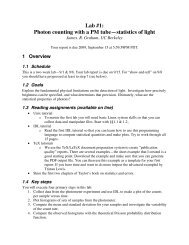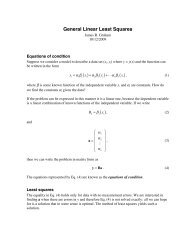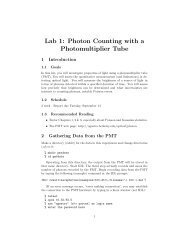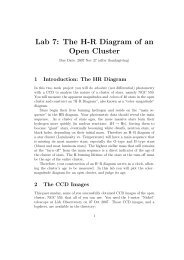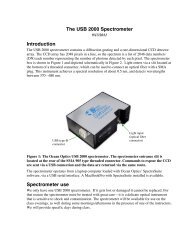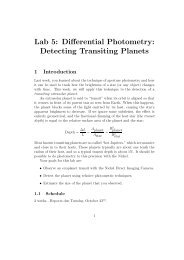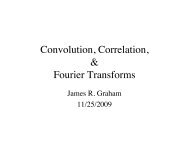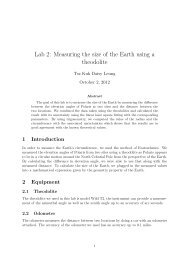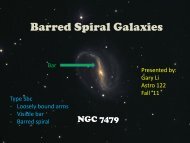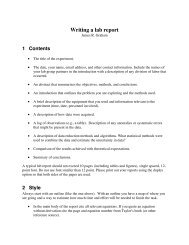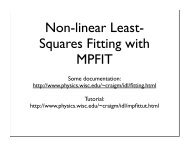Lab 6: Double Einstein Ring System SDSSJ0946+1006 - UGAstro
Lab 6: Double Einstein Ring System SDSSJ0946+1006 - UGAstro
Lab 6: Double Einstein Ring System SDSSJ0946+1006 - UGAstro
Create successful ePaper yourself
Turn your PDF publications into a flip-book with our unique Google optimized e-Paper software.
pixels. The absolute pixel differences between the centroids of the inner ringemissions and the central galaxy emission are therefore 14.2 ± 1.29 pixels(to the upper ring) and 11.3 ± 1.29 pixels (to the lower ring). Averagingthese two pixel regress gives the mean pixel annulus of the inner ring to be12.75 ± 1.29 pixels. Multiplying this number by the plate scale of WF3, 0.1arcsec/pixel, we get the angular separation of the inner annulus to be 1.275± 0.129 arcseconds. We can confidently detect only one side of the outer ringemission, due to it being fainter. The pixel difference between the centroid ofthe central galaxy and the centroid of the outer ring emission is 23.3 ± 1.29pixels. Again, multiplying this number by the plate scale of WF3 gives usthe angular separation of the outer annulus to be 2.33 ± 0.129 arcseconds.If we are to use, instead of the high pass filter, the model galaxy subtractedimage from the previous section, we would gain another method bywhich we can calculate the rings’ radial angular separation. Taking a radialcut of the image at the same location, we would obtain the same centroidpositions for the rings’ emissions. However, we would need a new methodto find the center of our lensing galaxy. Since our model galaxy succeededin canceling out the actual galaxy, then the location of the galaxy’s centershould be located at the position we placed the center of the model galaxy[366.475, 376.860]. The vertical position of our galaxy is therefore 376.860.This corresponds to pixel number 33.86 in Figure 5 (the image in Figure 5starts at pixel 343, therefore, the pixel position of the model galaxy in Figure5 is pixel number 376.860 − 343 = 33.86). The absolute pixel differencesbetween this new centroid and the two inner ring emission lines visible inFigure 5 are 12.86 (for the distance to the upper ring) and 12.64 (for thedistance to the lower ring). Since the rings’ emission centroids still carrythe centroid uncertainty, these values have uncertainty of ± 1.29 pixels. Theaverage of these values again give us the average pixel angular separation ofthe inner annulus to be 12.75 ± 1.29 pixels, or multiplying by the plate scale,1.275 ± 0.129 arcseconds. Doing the same procedure with the single outerring centroid give the angular separation of the outer ring to be 24.64 ± 1.29pixels, or multiplying by the plate scale, 2.464 ± 0.129 arcseconds. The factthat we get similar answers using both methods means that for the purposesof this lab, it does not really matter which method were used in subtractingthe lensing galaxy.16




